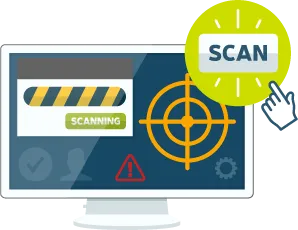This website uses cookies to ensure you get the best experience on our website. Learn more

How to secure hybrid cloud environments: Best practices for cloud password security
Table of Contents
As more organizations adopt cloud-first or hybrid IT strategies, identity and access management (IAM) has taken on a new level of complexity. According to a recent report from Flexera, 89% of enterprises now use a multi-cloud strategy, with many maintaining a combination of public cloud, private cloud, and on-premises environments.
As well as changing where data and applications reside, this shift to cloud and hybrid infrastructures transforms how users access them. Traditional security controls designed for centralized, on-prem environments don’t necessarily scale effectively in these distributed systems, making cloud password security a growing priority.
In this article, we’ll explore the unique password security challenges that arise in these circumstances, and outline actionable tips to help you protect access and secure your hybrid cloud environment.
Understanding the unique security challenges for cloud and hybrid environments
Cloud and hybrid architectures decentralize infrastructure, creating a broader and more complex attack surface. As a result, password security becomes more difficult to manage uniformly, leading to potential security gaps that threat actors can use to their advantage.
A few key challenges for cloud and hybrid environments include:
- Multiple identity providers: Organizations often rely on a mix of providers like Entra ID, Okta, AWS IAM, and legacy systems. This can easily lead to inconsistent password policies and enforcement, with IT and security teams struggling to keep track.
- Third-party SaaS tools: Third-party cloud-based apps may not integrate well with central IAM systems, creating isolated identity silos that are difficult to monitor.
- Shared responsibility models: When you use cloud services, some of the security responsibility lies with the cloud provider. However, you are still responsible for a level of security, too, including protecting access to your apps and data.
Why is cloud password security important?
Weak, reused, or compromised passwords remain one of the leading causes of a data breach. In fact, Verizon’s 2025 Data Breach Investigations Report found that 88% of attacks against basic web applications involved the use of stolen credentials.
The risk is amplified in hybrid environments, where many organizations federate their on-premises Active Directory with cloud identity providers to enable single sign-on (SSO). While this streamlines access, it also extends the blast radius: if an on-prem AD account is compromised, that compromise can extend to the cloud through federated access, giving attackers a foothold across systems.
This is why intentional, effective cloud password security measures are essential for any organization relying on cloud, whether 100% cloud based or hybrid with on-prem. Done right, effective cloud security helps:
- Prevent breaches by reducing the attack surface tied to weak or breached credentials.
- Support Zero Trust strategies by strengthening identity as the primary control perimeter.
- Meet compliance requirements like GDPR, HIPAA, and NIST, which mandate secure authentication and password management practices.
Best practices for hybrid and cloud password security
In cloud environments, password security is a first line of defense against unauthorized access and credential-based attacks. Fragmented policies and lack of MFA create opportunities for attackers to exploit inconsistencies. To build resilience, organizations need to take a unified, proactive approach to password protection across all environments.
1. Enforce unified password policies across environments
Disparate password policies are one of the most common (and avoidable) vulnerabilities in cloud and hybrid environments. When cloud platforms and on-prem systems enforce different rules, attackers target the weakest one, which is often a neglected SaaS app or outdated legacy system.
Organizations should adopt unified password policies that apply consistently across all identity providers, whether that’s Active Directory, Entra ID, or a cloud HR platform. This includes:
- Using strong, complex passphrases: As well as being more memorable, a passphrase like “CoffeeMonkeyEmotion&” is much more resistant to brute-force attacks than something like “P@ssw0rd123”.
- Blocking breached or commonly used passwords: Attackers often rely on credential stuffing and dictionary attacks using lists of known passwords, so allowing these poses an immediate risk. For an easy solution in Active Directory environments, Specops Password Policy with Breached Password Protection can block the use of over 4 billion unique compromised passwords. Sign up for a free demo here.
2. Use centralized Identity and Access Management (IAM)
Many organizations rely on a mix of cloud-native apps, third-party SaaS services, and traditional on-prem systems. Without centralized control, visibility suffers due to fragmented password management, meaning weak or unmanaged credentials often slip through the cracks.
Centralized IAM tools bridge that gap by integrating with multiple environments, providing unified visibility and policy enforcement. These platforms can help security teams apply consistent password policies across all connected systems and closely monitor password hygiene.
It’s important to note that in many hybrid environments, Active Directory (AD) is still widely used as the core identity source, but its default password controls can be overly permissive, often accepting weak but technically “complex” passwords like Password1234. This creates risk even when IAM is centralized.
To address these gaps, organizations should extend their IAM infrastructure with enhanced password policy enforcement and layered security tools. Solutions like Specops Password Policy help enforce stronger, real-world password requirements in hybrid environments.
3. Enable multi-factor authentication (MFA)
Even the strongest password can be compromised. That’s why MFA should be a baseline requirement for securing access, especially in cloud or hybrid setups where traditional network perimeter defenses are blurred.
MFA adds a second (or third) layer of verification, including at least two of these three factors:
- Something you know: Passwords or security codes.
- Something you have: Physical authenticators like USBs, access cards, or mobile devices.
- Something you are: Biometric identifiers like facial recognition or fingerprints.
In a cloud context, MFA can help mitigate risks from phishing, credential stuffing, and brute-force attacks, especially for remote or privileged access. When MFA is enabled, even if an attacker steals a user’s password, they still won’t be able to gain access.
However, MFA isn’t a silver bullet. Users can lose access to physical authenticators or change devices, often requiring a fallback to passwords during recovery. Without secure self-service options or service desk controls, these scenarios can reintroduce risk. That’s why it’s important to pair MFA with secure account recovery workflows that prevent attackers from bypassing protections through social engineering or weak reset procedures.
4. Strengthen password resets with secure verification
A critical, often overlooked vulnerability when it comes to cloud password security lies in the password-reset workflow, which often involves service‑desk agents verifying and resetting credentials over the phone.
Attack groups like Scattered Spider have weaponized this route, using social engineering to manipulate help‑desk staff into granting unauthorized resets—even bypassing MFA. If an attacker manages to bypass security measures through service desk social engineering and gain access to cloud-based portals, they can easily move laterally and compromise a wide range of systems.
Specops Secure Service Desk can help close this gap, enforcing strong user verification before any password reset occurs. The tool integrates with a multitude of ID services and other service desk systems such as Service Now and Jira. It’s also able to support on-premises, hybrid, and Entra ID only organizations, enabling service desk security across all environments. Book your demo or trial today to see it in action.
5. Provide self-service password reset options
Password-related helpdesk tickets, especially resets, are a persistent drain on IT resources. Research from Gartner found that 40% of all calls to the service desk are related to passwords, and Forrester estimates each reset costs $70.
Implementing self-service password reset (SSPR) tools reduces this burden significantly while improving user experience. In cloud environments where users may be remote or working across time zones, having a frictionless reset process is essential to minimize downtime and prevent insecure workarounds.
Our SSPR solution, Specops uReset, lets users securely reset their Active Directory and Entra ID passwords from any location, device, or browser, with a range of 20+ identity service providers including Duo, Microsoft Authenticator, Okta, Entra ID and more. Try uReset for free here.
6. Monitor password synchronization tools for vulnerabilities
In hybrid environments, synchronization tools like Microsoft Entra Connect play a critical role in bridging on-prem directories with cloud identity platforms. These tools enable seamless sign-on experiences by syncing credentials, but they can also introduce security blind spots if they’re left unmonitored.
To reduce risk, restrict access to synchronization servers and monitor them closely for unauthorized changes. You should also audit synchronization logs regularly to verify which accounts and password changes are flowing between environments. Tools like Microsoft Entra Connect Health can help with this, allowing you to track sync status and detect anomalies.
How to securely integrate MFA with cloud services
MFA is a must-have in any cloud or hybrid security model. It mitigates the risk posed by compromised passwords and is essential for meeting most regulatory frameworks, including NIST and CJIS.
Here are some best practices for seamlessly and securely integrating MFA across cloud services:
- Modern MFA methods: Opt for modern methods, like one-time passcodes sent to an authenticator app, over SMS-based authentication. For example, Specops Secure Access adds an important MFA layer that allows users to authenticate with with biometrics or push notifications via the Specops:ID mobile app. Try it for free here.
- Consistency: As with password policies, ensure consistency in MFA use across environments. On-prem systems and cloud apps should follow the same MFA requirements wherever possible.
- Adaptive policies: MFA isn’t usually necessary every time a user accesses a service, however there are some situations where it is absolutely crucial. These include when connecting to a service for the first time, logging in from a new device or location, or when accessing high-risk accounts (e.g. those with access to sensitive data or financial information). Adaptive policies mean you can trigger MFA based on things like IP address, device health or unusual user behavior.
How to secure cloud-based password managers
Research has shown time and time again that, despite unique passwords being paramount for effective security, people often reuse the same password across multiple accounts. This largely comes down to convenience, with a LastPass study revealing that 42% of respondents valued a password that’s easy to remember over one that’s secure.
Cloud-based password managers are an effective solution to this problem, helping to eliminate password reuse. They also make credential sharing between employees more secure and support secure access to third-party tools.
However, password managers are only effective when used responsibly and securely. Here are some top tips for securing a cloud-based password manager:
- Choose a reputable provider: Opt for a password manager with a strong security track record. Ideally, it should undergo regular third-party audits, publish transparent security documentation, and have no history of data breaches. A reputable provider will also offer timely security updates and support integrations with your existing identity infrastructure.
- Ensure strong encryption standards: Make sure the manager supports strong end-to-end encryption via a gold-standard algorithm like AES-256. You should also make sure it follows a zero-knowledge architecture, meaning even the provider cannot access your data.
- Use a strong, unique master password: The master password grants access to the entire vault of stored credentials, so it’s vital that it’s strong and secure. When using an enterprise password manager, you can use a tool like Specops Password Policy to enforce tight security standards on the master password, including blocking compromised and weak passwords. However, make sure to check which authentication platforms your password manager is compatible with.
- Enable MFA: NCSC guidelines recommend using MFA on any password manager account, so that even if the master password is compromised, hackers won’t be able to gain access.
Tighten cloud password security with Specops Password Policy
Active Directory is often used to federate access to third-party cloud services. This centralized identity management has many security benefits and can provide a smoother experience for end users. However, it can also lead to devastating consequences if Active Directory credentials are compromised, leaving all connected cloud services vulnerable.
Specops Password Policy provides a much-needed line of defense for your Active Directory credentials. With the integrated Breached Password Protection service, you can continuously block over 4 billion compromised passwords in on-prem and hybrid environments. Users also receive dynamic feedback at password creation, guiding them to create strong passwords that meet security standards.
Keen to find out more about how Specops Password Policy can help improve your cloud password security? Sign up for a live demo today.
Last updated on November 11, 2025




